英语人教版九年级全册unit5 Section B 2b
Unit+5+Section+B+课件2024-2025学年人教版英语九年级全册+
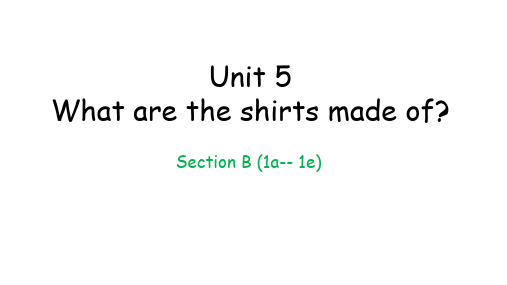
Laura
Listen for the general idea of 1b.
The general idea of the conversation is about ___B____. A. how to make a kite B. the kite festival C. how to fly a kite
• 5.He ___l_o__o_k_e__d__f_o_r___(寻找) his book all over his office,but he failed
at last.
二、用方框中所给词的适当形式填空。
vacation kite international find compete 1.—What did you do on your _____v_a_c_a_t_io_n____? —I went to visit Beijing. 2.Before the competition,most _________c_o_m__p_e_ti_to_r_s are nervous. 3.We've _____f_o_u_n_d___ a great new restaurant near the office. 4.There are many people from all over the world in Shanghai,so it is an ______in_t_e_rn_a_t_io_n_a_l_____ city. 5.She collects a lot of _____k_it_e_s____.
Listen again. Fill in the blanks with what you hear.
1d
Laura
Zheng Yun
Unit+5Section+B+教案+2024-2025学年人教版英语九年级全册

Unit 5 What are the shirts made of?Section B(1a-1e)Teaching Aims 1.语言能力:能够了解风筝是用什么材料制作的。
2.文化意识:了解山东潍坊的国际风筝节3.思维品质:能够从听力材料中获取相关的信息。
4.学习能力:有意识地运用被动语态谈论产品用什么制造,在哪儿制造。
TeachingDifficulties Develop Ss’ ability to use the target language to talk about certain topics. TeachingAids A tape recorder; CAI or multimedia coursewareTeaching Procedures Tips Step 1 Warm-up➢The T can play a video about kinds of kites to arouse Ss’ interest and broaden their eyes. Then Ss can have some discussions usingtheir prior knowledge. The T may use these prompts:Have you ever seen so many kites?How do you like them?Have you ever tried flying kites ?...➢Then the T can play the other video about Weifang International Kite Festival to introduce some background knowledge to Ss . Thenthe T can make Ss brainstorm what materials are needed to make akite. The T can use these prompts:Have you ever made a kite?What materials or tools do we need to make a kite?Then the T can list the materials and tools on the board so that Ss can have a review of these words and phrases.Step 2 Presentation & Practice➢1aThis activity is to review the target language for talking aboutwhat things are made of. If feasible, the T may bring one or twokites to class and have Ss identify the materials used to make those kites. Alternatively, the T may ask Ss prior to this lesson to bring any kites they might have for this lesson.➢1aSs look at the pictures in 1a and the T can ask some questions such as“Are they bees? Are they flies? Is this a butterfly? ” to help Ss toreview the learned words. Ss finish the task in 1a and share their answers by making conversations using the target languagestructure in pairs.Suggested answers: paper, silk, nylon, wood/bamboo➢1bBefore-listening, the T can ask Ss to look through the context in 1b to predict. The T may use these prompts:If Laura wants to know what Zheng Yun did on his vacation,she may ask Zhang Yun:What did you do …?What happened …?What took place …?If Laura wants to know what Zheng Yun thinks about Weifang,she may ask Zheng Yun:How is …?How do you find …?How do you like …?➢1bThe T can play the recording and Ss finish the task in 1b. Then the T can invite some Ss to share answers by asking the followingquestions and then the T can make feedback.What is Laura trying to find out more about?Does Zheng Y un tell Laura about a kite festival or how to make akite?Why did you choose that answer?Answers: 1.A 2.A➢1bAfter Ss have completed activity 1b, the T may want to ask Ss to listen to the recording again and identify the superlatives used to describe the kites. (best/highest)➢1cThis activity is to give Ss practice in listening for specificinformation. The T can ask Ss to look through the sentences in 1c before playing the recording .Ss finish the task in 1c and the T can nominate Ss to share their answers .Answers:1.Z2.L3.Z4.L5.L➢1dThis activity is to give Ss further practice in listening for specificinformation. Before playing the recording again, the T can have Ss work in pairs to predict answers in 1d so that they can be morefocused when listening. Then the T present the correct answers.Answers:1.kites2.April3.all over the worldpetitions5.silk or paper; drawings.➢1eTo provide Ss with speaking practice using the target language, the T can invite Ss to role-play the conversations between Laura and Zheng Yun. Or make them work in closed pairs. The T can observe the Ss’ performance and provide support when necessary.Other options:The T may have Ss work in pairs to make a conversation aboutother festivals they have been to, then invite a few pairs torole-play their conversations for the class.Step 4 Language points learning➢international adj. 国际的international作形容词,由“inter-(前缀)+ nation(n. 国家;民族)+ -al(形容词后缀)”构成。
人教版九年级英语全册Unit5SectionB2a2b教学设计

-教师提问:“What do you think are the key factors to success?”,引导学生分享对成功的看法。
3.分层教学:针对不同学生的学习水平,设计不同难度的练习,使每个学生都能在原有基础上得到提高。
7.教学评价:采用多元化评价方式,关注学生的语言能力、合作意识、情感态度等方面的发展。
-结合课堂表现、作业完成情况、小组活动等,全面评价学生的学习效果。
四、教学内容与过程
(一)导入新课
1.教师以一个名人故事引入新课,如讲述马云创立阿里巴巴的经历,引导学生思考成功背后的因素。
-提问:“Can you guess what made Ma Yun successful? What do you think are the key factors to his success?”
-提示:可以从词典、网络资源、英文文章中寻找相关词汇和短语。
5.课后反思:回顾本节课的学习内容,思考以下问题,并在下节课上与同学分享:
- What have you learned from the success stories of celebrities?
- How will you apply these lessons to your own life and studies?
1.写作练习:请结合本节课所学的重点词汇和语法知识,以“Fame and Success”为主题,写一篇英文短文。要求不少于80词,描述你心目中的一个成功人士,并阐述他/她的成功原因。
-提示:可以从名人的努力、坚持、团队精神等方面入手,结合具体事例进行描述。
2.小组活动:小组内讨论并分享各自采访家人或朋友的成功经历。每组选取一个最具启发性的故事,准备在下节课上进行课堂展示。
英语人教版九年级全册Unit 5 sectionB (2a-2d)

1. sky lanterns 2. paper cutting 3. clay art
bamboo, paper paper clay
2c Read the passage again and
answer the questions.
1. What do traditional Chinese art forms try to show? (第一段) =>They try to show the things that are important in life ,such as love, beauty and family.
It’s one of the Chinese traditional பைடு நூலகம்rts.
知识点 1:
1. 了解:know about 2. 传统艺术:traditional art 3. 剪纸: paper cutting
介绍:(书面表达) Paper cutting
Paper cutting is one of _th__e_m__o_st__p_o_p_u_la_r_ traditional folk arts in China. During the Spring Festival and wedding婚礼 celebrations, theya_r_e_u__se_d__to_ decorate装饰 doors, rooms and windows. Chinese paper cutting is very popular _a_r_o_u_n_d_t_h_e__w_o_r_l_d_, which is often used as be the gift for foreign friends.
3. What kinds of pictures are usually found on paper cuttings?
人教版九年级英语全册Unit5SectionB2a2e优秀教学案例
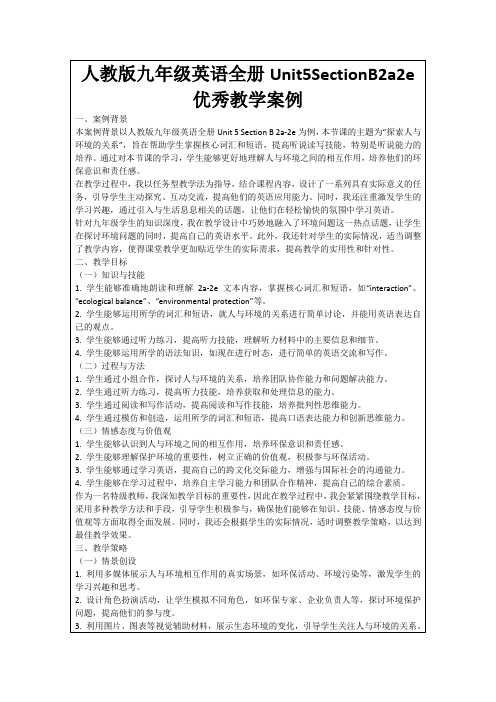
3.教师对学生的学习成果进行评价,关注他们的全面发展,给出建设性的反馈,帮助他们不断成长。
作为一名特级教师,我深知教学策略的重要性,因此在教学过程中,我会根据学生的实际情况,灵活运用各种教学策略,确保他们在知识与技能、过程与方法、情感态度与价值观等方面取得全面发展。同时,我还会关注学生的个体差异,给予他们个性化的指导和支持,帮助他们实现自己的潜能。
(二)问题导向
1.设计具有启发性的问题,引导学生主动探究人与环境的关系,如“人类活动如何影响生态环境?”“如何平衡经济发展与环境保护?”等。
2.引导学生通过讨论、调查、研究等方法,寻找问题的答案,培养他们的问题解决能力。
3.鼓励学生提出自己的观点和看法,激发他们的批判性思维和创新能力。
(三)小组合作
四、教学内容与过程
(一)导入新课
1.利用多媒体展示一系列与环境相关的图片,如美丽的自然风光、污染严重的河流等,引导学生关注人与环境的关系。
2.向学生提出问题:“你们认为人与环境是怎样的关系?”让学生发表自己的看法,激发他们的思考。
3.简要介绍本节课的主题和目标,引导学生明确学习任务。
(二)讲授新知
1.引导学生学习2a-2e文本内容,讲解核心词汇和短语,如“interaction”、“ecological balance”、“environmental protection”等。
3.学生能够通过听力练习,提高听力技能,理解听力材料中的主要信息和细节。
4.学生能够运用所学的语法知识,如现在进行时态,进行简单的英语交流和写作。
(二)过程与方法
1.学生通过小组合作,探讨人与环境的关系,培养团队协作能力和问题解决能力。
人教版初中英语九年级英语全册Unit 5 Section B 2a-2e
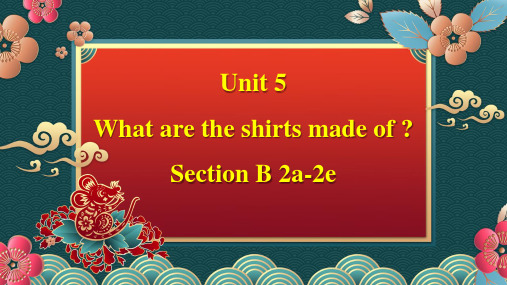
the structure of this writing:
1
1 23
1
23
234
4
4
A
B
C
Gerneral Introduction
Specific details (具体细节)
One kind of structure of expositions(说明文)
Step3 While-reading—Scanning Read para.1 and fill in the blanks.
3. Retell the steps for making clay art pieces.
The steps for making clay art pieces
First,
Then,
They are __s_h_a_p_e_d_
They _a_re__f_ir_e_d_ at very high
Q1.What do traditional Chinese art forms try to show? Traditional Chinese art forms try to show thes_p_e_c_ia_l_f_o_rm__s_o_f_t_r_a_d_itiionnlaiflea, rstuch
1. Review the key knowledge of this lesson. 2. Retell the passage.
Unit 5 What are the shirts made of ?
Section B 2a-2e
Step1 Lead in
Some forms of tradtional art
facial makeup
人教版英语九年级全册Unit5SectionB(2a~2e)教学设计
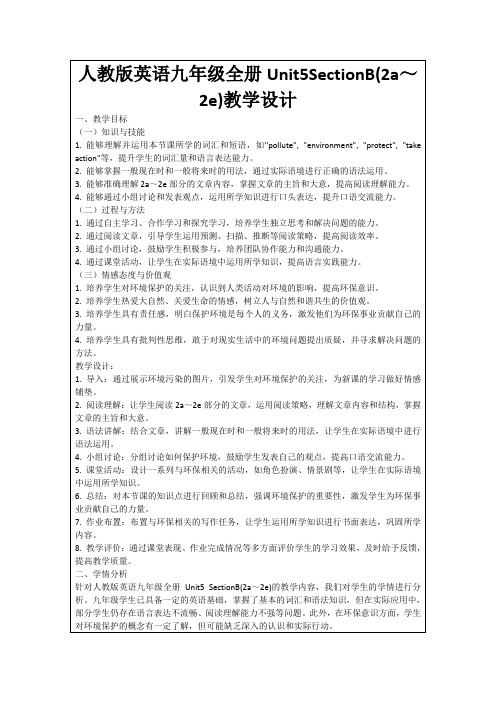
3.学生分享:鼓励学生分享自己的观点和感受,为后续的小组讨论预热。
(二)讲授新知
1.词汇和语法讲解:结合2a~2e部分的文章,讲解本节课的词汇和语法点,如一般现在时和一般将来时的用法,并通过例句展示其在实际语境中的应用。
3.实践作业:
-设计一份环保宣传海报,内容包括环保标语、本节课所学的环保知识等,培养学生的学习迁移能力。
-参与一次环保活动,如植树、垃圾分类等,记录活动过程和心得体会,将实践成果带回课堂分享。
4.阅读拓展:
-阅读一篇关于环保的英文文章,提高阅读水平,拓宽知识面。
-观看一部与环保相关的英文纪录片,了解世界各地的环保现状和成功案例,激发学生的环保热情。
5.课后反思:
-写一篇课后反思,总结本节课的学习收获,以及自己在环保方面的认识和行动。
-分析自己在课堂上的表现,找出优点和不足,为今后的学习制定具体目标。
教师将根据学生的作业完成情况,给予及时反馈和评价,鼓励学生持续进步,提高他们的英语素养和环保意识。同时,教师应关注学生的作业质量,适时调整教学策略,以确保作业的有效性和实用性。
5.拓展延伸:鼓励学生在课后关注和参与环保活动,将课堂学习与生活实际相结合,促进知识的内化和行为的变化。
6.教学资源的利用:充分利用教材、网络资源和其他教学辅助材料,丰富教学内容,提高教学效率。
四、教学内容与过程
(一)导入新课
1.教学活动设计:通过展示一系列环境污染的图片,如被污染的河流、空气污染严重的城市等,引发学生对环境保护的关注,为新课的学习做好情感铺垫。
-写一篇短文,主题为“我身边的环保行动”,要求运用本节课所学的词汇和语法,描述自己或他人为保护环境所采取的具体行动,不少于100词。
人教英语九年级全册Unit5SectionB2bBeautyinCommonThings说课稿
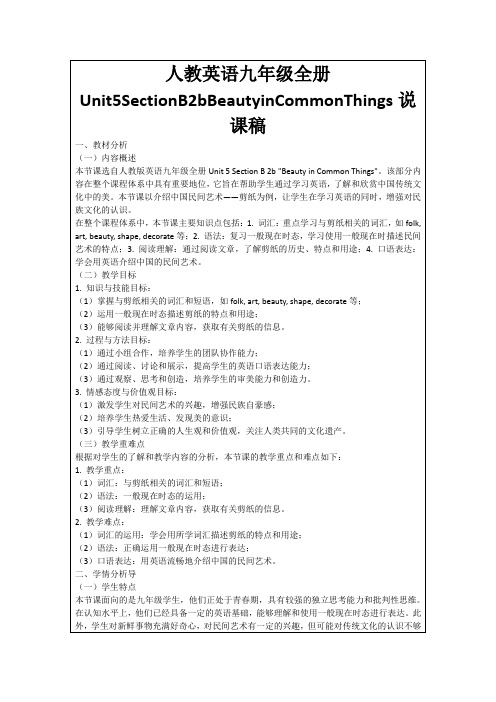
在总结反馈阶段,我将采取以下措施引导学生自我评价,并提供有效的反馈和建议:
1.让学生回顾本节课所学内容,自我评价在词汇、语法、阅读和口语表达方面的掌握情况。
2.组织学生互相评价,鼓励他们提出优点和不足,学会欣赏他人的优点,改进自己的不足。
3.教师对学生的表现给予积极评价,针对不同学生的特点,提供有针对性的反馈和建议。
可能存在的学习障碍有:1.词汇方面:对与剪纸相关的词汇和短语掌握不足,影响阅读理解和表达;2.语法方面:对一般现在时态的运用不够熟练,可能导致表达不准确;3.口语表达方面:用英语介绍民间艺术时,可能存在语言组织困难,表达不流畅。
(三)学习动机
为了激发学生的学习兴趣和动机,我将采取以下策略或活动:
1.创设情境:通过展示剪纸作品,让学生身临其境地感受民间艺术的魅力,激发学习兴趣;
1.针对学生兴趣,调整教学策略,提高课堂趣味性;
2.加强对学生的个别辅导,关注学习困难学生;
3.优化课堂教学环节,提高学生的参与度和合作能力;
4.持续关注学生的学习进步,及时调整教学方法和手段,提高教学质量。
选择依据:任务型教学法有助于培养学生的自主学习能力和合作精神,提高学生的实践能力。
3.交际法:鼓励学生进行口头表达,通过师生、生生之间的互动,提高学生的口语交流能力。
选择依据:交际法有助于培养学生的实际运用能力,提高学生的英语口语水平。
(二)媒体资源
我将使用以下教具、多媒体资源和技术工具:
1.教具:剪纸作品、卡片等。
2.加强课堂互动,及时发现并解决学生在词汇和语法方面的问题;
3.鼓励学生大胆开口,创设轻松愉快的课堂氛围,提高学生的口语表达能力。
课后评估教学效果:
1.检查学生的课后作业完成情况,了解学生对知识的掌握程度;
英语人教版九年级全册unit 5 section B 2b
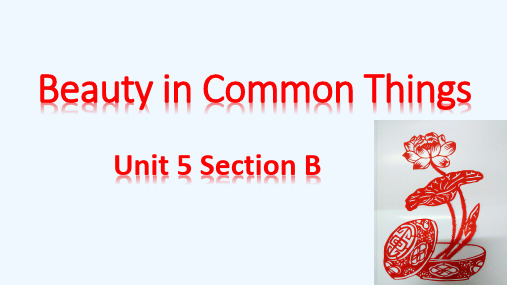
Beijing opera facial masks
Chinese paintings
Paragragh 2: sky lanterns
When Zhuge Kongming was in trouble, he sent out sky lanterns to ask for help
Read Paragragh 2 抢答
1. Are sky lanterns used at festivals and celebrations now?
( T )3. They are put on windows, doors
and walls as symbols of good luck。
Paragraph 4 (one word to describe each picture)
the process of clay art
3
4
1
2
ห้องสมุดไป่ตู้clay
New words:
1. form
n. 形式, 类型
2. clay
n. 陶土, 黏土
3. celebration n. 庆典,庆祝活动
4. balloon n. 气球
5. scissors n. 剪刀
6. lively
adj. 鲜艳的, 生气勃勃的
7. historical adj. 有关历史的
8. heat
11高温烧制
1.paper cutting 2.turn ......into 3.sky lanterns 4.send out 5.cover......with 6.in trouble 7.rise into the air 8.be put on windows 9.light the lanterns 10.clay pieces 11.fire at a very high heat
人教版九年级全册英语Unit5SectionB2a2e优秀教学案例

3.通过学习英语,培养学生对不同文化的尊重和理解,提高他们的跨文化交际能力。
4.通过对过去发生的事情的描述,培养学生的思考能力,让他们学会从不同角度看待事物,提高他们的思维能力。
作为一名特级教师,我明白教学目标的重要性,它是我们教学的出发点和归宿。在教学过程中,我会时刻关注学生的学习情况,根据他们的反馈,及时调整教学方法和策略,以确保他们能够达到预设的教学目标。同时,我也会注重激发学生的学习兴趣,营造轻松、愉快的学习氛围,让他们在愉悦的情感状态下学习英语。
2.利用示例,讲解过去时态的构成,如:“Regular verbs add 'ed' at the end, and irregular verbs change the form.”,让学生明确过去时态的规则。
3.通过练习,让学生区分一般过去时和过去进行时,如:“I watched a movie last night.”与“I was watching TV last night.”,引导学生掌握过去时态的两种形式。
3.教师通过讲述一个发生在过去的故事,如:“When I was a child, I often visited my grandma's farm...”,以引起学生对过去发生事情的回忆,为学习过去时态做好铺垫。
(二)讲授新知
1.通过展示一系列含有过去时态的句子,如:“He visited his grandma's farm last week.”,引导学生注意过去时态的构成和用法。
2.引导学生注意使用恰当的过去时态,如:“I went to the beach with my family last summer.”,鼓励学生运用所学知识进行实际交流。
人教版九年级英语全册Unit5SectionB2a2e教学设计

4.重视写作教学,指导学生运用一般过去时编写故事或日记。在此过程中,关注学生的语言表达,及时给予反馈,提高学生的写作能力。
5.情感态度与价值观的培养,结合教学内容,设计相关话题,引导学生关注环境保护、跨文化交际等方面。例如,在讨论过去经历时,引导学生思考如何保护环境,从自身做起。
5.阅读一篇关于历史事件的英文文章,并完成相应的阅读理解练习。文章中涉及一般过去时的动词形式和句子,要求学生在阅读过程中注意理解并运用。
6.结合教材中的语法知识点,整理一般过去时的动词变化规则,制作成语法卡片,便于随时复习。
7.学生针对本节课的学习内容,总结自己在一般过去时运用方面的优点和不足,并制定相应的提高计划。
四、教学内容与过程
(一)导入新课
1.教师通过展示一组图片,图片内容为学生熟悉的日常场景,如:去公园、参观博物馆、过生日等。引导学生观察图片,并提问:“What can you see in these pictures? What do you think happened in these situations?”
3.教师展示一段与一般过去时相关的听力材料,引导学生捕捉关键信息,并示范如何用一般过去时回答问题。
4.教师挑选一些典型句子,让学生分析句子结构,理解一般过去时的用法。
(三)学生小组讨论
1.教师将学生分成小组,每组选择一个话题,如:my last vacation, a memorable day等。
4.关注环境保护,从自身做起,养成良好的生活习惯;
5.培养良好的团队协作精神,学会与他人共同学习、共同进步。
人教版九年级英语全 Unit 5 Section B (2a-2b)教学设计

人教版九年级Unit 5 What are the shirt s made of?Section B 2a~2b Beauty in Common Things一、教学设计(一)教学目标1.语言知识:1) 能掌握并运用介绍中国传统艺术的相关词汇:its, form, clay, celebration, balloon, paper cutting, scissors, lively, fairy tale, historical, heat, polish, complete,turn...into, such as, send out.2) 能运用介绍传统艺术的相关句型:① They are made of….② According to Chinese history, sky lanterns were first used by…③ They are seen as bright symbols of…④ After drying, they are fired at a very high heat.3)能掌握并合理运用一般现在时的被动语态2.语言技能1)听:学生能够听懂教学活动内容及课堂用语。
2)说:学会谈论中国传统艺术形式,并能根据交际需要运用英语与伙伴和老师交流。
3)读:能够根据需要运用略读、跳读、细读等方法理解文章,掠取有效信息以解决问题,并掌握阅读技巧:从文章大意到具体细节等。
4)写:能够通过阅读搭建图式支架,积累写作素材,实现知识迁移并进行创作,即撰写说明文:介绍家乡的传统艺术形式,并完成书面作业。
3.文化意识1)了解中国的传统文化元素,领略中国传统艺术形式的魅力,加深对祖国文化理解的过程。
2)学生初步形成跨文化交际意识,能初步用英语介绍祖国的优秀传统文化。
4.情感态度1)学生对祖国传统艺术形式能有更深刻的了解,具有初步的国际理解意识。
2)通过详细了解中国传统工艺品和家乡优秀传统艺术,树立民族自豪感及爱国、爱家的情怀。
人教英语九年级全册Unit5SectionB2bBeautyinCommonThings优秀教学案例

4.情感态度与价值观的培养:本节课通过讨论和分享,使学生认识到生活中美好事物的存在,并学会发现和欣赏生活中的美。通过引导学生的思考和表达,教师帮助他们培养了积极乐观的人生态度和关爱他人的意识。这种情感态度与价值观的培养,使学生在学习知识的同时,也得到了精神的滋养和成长。
四、教学内容与过程
(一)导入新课
1.教师展示一幅描绘平凡生活中的美景的图片或视频,如一个孩子在阳光下玩耍、一对老夫妇携手漫步在公园等,引导学生关注并欣赏生活中的美好事物。
2.教师提问:“你们认为什么是最美好的事物?”让学生分享自己的看法和经历,激发学生的学习兴趣和好奇心。
3.教师引出本节课的主题:“今天我们将继续学习Unit 5 Section B 2b 'Beauty in Common Things',让我们一起探索作者是如何发现和欣赏生活中的美好的。”
5.教学策略的灵活运用:教师在本节课中灵活运用了情景创设、问题导向、小组合作和反思与评价等教学策略,使教学过程丰富多样,激发了学生的学习兴趣和积极性。教师还能够根据学生的反馈和表现,及时进行调整和指导,确保每个学生都能在课堂上得到充分的参与和成长。这种教学策略的灵活运用,体现了教师的教育智慧和教学能力,使教学效果更加显著。
2.能够理解并运用文章中的关键句型和语法结构,如“There is beauty in common things if we take the time to notice.”和“We often don’t appreciate the beauty in common things until they are gone.”,提高学生的语法运用能力。
人教版九年级英语全Unit5SectionB(2a2e)教学设计

4.能够运用所学词汇和句型进行情景对话,并能进行简单的角色扮演活动。
5.能够通过阅读理解文本,获取关键信息,提高阅读技巧。
难点:引导学生运用阅读策略,如预测、推理、总结等,提高阅读效率。
3.重点:培养学生的口语表达能力和听力理解能力。
难点:如何克服学生的语言焦虑,鼓励他们在课堂上积极发言,提高听说技能。
(二)教学设想
1.针对重难点的教学设想:
a.利用多媒体教学资源,如动画、视频等,创设生动有趣的情境,让学生在情境中感知和运用过去进行时态和一般过去时态。
4.在情感态度方面,大部分学生对英语学习保持积极态度,但仍有一部分学生对英语学习存在恐惧心理,教师应关注这部分学生的心理需求,给予鼓励和支持,提高其学习自信心。
5.由于本章节涉及到的词汇和句型较为丰富,学生对新知识的接受程度可能有所不同。教师应充分了解学生的个体差异,因材施教,使每个学生都能在原有基础上得到提高。
(二)过程与方法
在本章节的教学过程中,教师应注重以下过程与方法:
1.采用任务型教学法,设计丰富的课堂活动,引导学生积极参与,培养其英语实际运用能力。
2.通过小组合作、讨论等方式,让学生在互动中学习,提高其合作能力和沟通能力。
3.利用多媒体教学资源,如图片、视频等,创设情境,帮助学生更好地理解和运用所学知识。
b.建立英语学习小组,开展课外阅读活动,分享阅读心得,提升学生的阅读素养。
c.定期举办英语角活动,为学生提供与同伴交流的机会,提高其口语表达能力。
四、教学内容与过程
九年级英语人教版全册 Unit5_单元主题思维导图
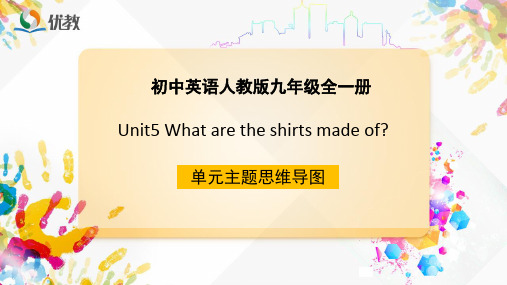
Clay art
1. be small, but look real 2. cute children or lively characters from a Chinese fairy tale or historical story 3. be shaped by hand from... 4. be allowed to air-dry 5. be fired at... 6. be polished and painted
Materials
plant, leaves, paper, cotton, silk, bamboo, plastic, wood, gold, silver, glass, steel
Traditional art forms
sky lanterns, paper cutting, Chinese clay art
初中英语人教版九年级全一册
Unit5 What are the shirts made of?
单元主题思维导图
Traditional art forms
阅读篇-SectionB 2b
Sky lanterns
1. be first used by... 2. be used for... in the past; be used at... today 3. be made of... 4. be covered with... 5. be seen as symbols of...
人教版英语九全Unit5 Section B(2b-2c)教学课件(共26张PPT)

Which art form do you think is the most
interesting? Why? (
)
Try to discover the beauty in common things and love your life.
REFLECTION & SUMMARY
Learn about some traditional art forms in China. Learn to move from general to specific. Be able to discuss traditional art forms using passive voice.
Assessment Item
1.What's your active behavior in this class?
2.What do you need to improve?
3.Who's your idol in this class?
4.Which team is the best in this class?
fi1r.sWt huosefdirstby Zhuusgeed sky Kolanngtmerinnsg?
2. Wuhsaetdwfeorre: thaesykiunsgedfoforr
in thheeplpast?in the past; at Whefnesatrievathlseynouswed now ?
你想英语学习轻松吗? 请养成良好的学习习惯! 1.请准备好课堂中要用的学习用品: 积分表+笔记本 + 练习本 + 错题本 + 双色笔 (学习的一把利剑)
+ 字典(无言的恩师) 2. 让我们的手+眼+嘴+耳+脑子动起来!!
英语人教版九年级全册unit5SectionB2b
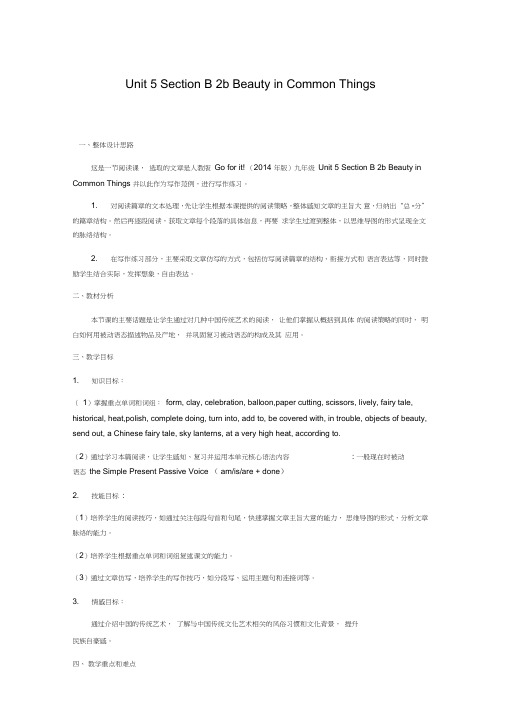
Unit 5 Section B 2b Beauty in Common Things一、整体设计思路这是一节阅读课,选取的文章是人教版Go for it! (2014 年版)九年级Unit 5 Section B 2b Beauty in Common Things 并以此作为写作范例,进行写作练习。
1. 对阅读篇章的文本处理,先让学生根据本课提供的阅读策略,整体感知文章的主旨大意,归纳出“总-分”的篇章结构。
然后再逐段阅读,获取文章每个段落的具体信息,再要求学生过渡到整体,以思维导图的形式呈现全文的脉络结构。
2. 在写作练习部分,主要采取文章仿写的方式,包括仿写阅读篇章的结构、衔接方式和语言表达等,同时鼓励学生结合实际,发挥想象,自由表达。
二、教材分析本节课的主要话题是让学生通过对几种中国传统艺术的阅读,让他们掌握从概括到具体的阅读策略的同时,明白如何用被动语态描述物品及产地,并巩固复习被动语态的构成及其应用。
三、教学目标1. 知识目标:(1)掌握重点单词和词组:form, clay, celebration, balloon,paper cutting, scissors, lively, fairy tale, historical, heat,polish, complete doing, turn into, add to, be covered with, in trouble, objects of beauty, send out, a Chinese fairy tale, sky lanterns, at a very high heat, according to.(2)通过学习本篇阅读,让学生感知、复习并运用本单元核心语法内容: 一般现在时被动语态the Simple Present Passive Voice ( am/is/are + done)2. 技能目标:(1)培养学生的阅读技巧,如通过关注每段句首和句尾,快速掌握文章主旨大意的能力,思维导图的形式,分析文章脉络的能力。
- 1、下载文档前请自行甄别文档内容的完整性,平台不提供额外的编辑、内容补充、找答案等附加服务。
- 2、"仅部分预览"的文档,不可在线预览部分如存在完整性等问题,可反馈申请退款(可完整预览的文档不适用该条件!)。
- 3、如文档侵犯您的权益,请联系客服反馈,我们会尽快为您处理(人工客服工作时间:9:00-18:30)。
Unit 5 Section B 2b Beauty in Common Things一、整体设计思路这是一节阅读课,选取的文章是人教版Go for it! (2014年版)九年级Unit 5 Section B 2b Beauty in Common Things 并以此作为写作范例,进行写作练习。
1.对阅读篇章的文本处理,先让学生根据本课提供的阅读策略,整体感知文章的主旨大意,归纳出“总-分”的篇章结构。
然后再逐段阅读,获取文章每个段落的具体信息,再要求学生过渡到整体,以思维导图的形式呈现全文的脉络结构。
2.在写作练习部分,主要采取文章仿写的方式,包括仿写阅读篇章的结构、衔接方式和语言表达等,同时鼓励学生结合实际,发挥想象,自由表达。
二、教材分析本节课的主要话题是让学生通过对几种中国传统艺术的阅读,让他们掌握从概括到具体的阅读策略的同时,明白如何用被动语态描述物品及产地,并巩固复习被动语态的构成及其应用。
三、教学目标1.知识目标:(1)掌握重点单词和词组:form, clay, celebration, balloon,paper cutting, scissors, lively, fairy tale, historical, heat,polish, complete doing, turn into, add to, be covered with, in trouble, objects of beauty, send out, a Chinese fairy tale, sky lanterns, at a very high heat, according to.(2)通过学习本篇阅读,让学生感知、复习并运用本单元核心语法内容: 一般现在时被动语态the Simple Present Passive Voice ( am/is/are + done)2.技能目标:(1)培养学生的阅读技巧,如通过关注每段句首和句尾,快速掌握文章主旨大意的能力,思维导图的形式,分析文章脉络的能力。
(2)培养学生根据重点单词和词组复述课文的能力。
(3)通过文章仿写,培养学生的写作技巧,如分段写、运用主题句和连接词等。
3.情感目标:通过介绍中国的传统艺术,了解与中国传统文化艺术相关的风俗习惯和文化背景,提升民族自豪感。
四、教学重点和难点1.培养学生通过扫读和略读快速获取文章主旨大意的能力,和运用思维导图梳理具体信息的能力,提高学生的语篇理解力和阅读效率。
2.通过对所选文章的结构与语言特点的分析,帮助学生总结归纳写作技巧,并运用于实际写作中。
五、教学策略根据本课教学目标和重难点,采用扫读、略读、画思维导图、双人活动、小组讨论、仿写等活动来引导学生自主学习。
六、教学用具多媒体、课件七、教学过程Stage1:Warming upStep1: GreetingStep2: Check the previewReview the new words and phases by doing some exercises, such as translating the new words from Chinese to English or from English to Chinese, and completing the sentences.Stage2: Pre-readingStep 1: Lead-inTask 1: Free Talk1.Ask the students to talk about some traditional art in their daily life.T: Do you know any forms of traditional art in our country?Ss: Beijing Opera in Beijing, Face-Chaning in Sichuan, lion dance in Guangdong, tiger-head shoes in the northern part of China...The conclusion is that each different part of China has its own special forms of traditional art.2.The teacher shows some pictures about more special forms of traditional art in different parts of China. Then, ask the students some questions:①What do you think of these forms of traditional art?②If you have a chance, which one do you want to learn? Why?Task 2: Using reading strategy ( Prediction )Ask students to read the title and look at the pictures in the text, then try to guess the main topic of the passage.(Reading strategy - Prediction: We can predict what the passage may talk about according to the topic and the pictures of the text.)Stage3: While-readingStep 1: Scanning ( Reading for structure)Ask students to read the passage quickly and find out the structure of this passage. The teacher will give students some questions to help them.Questions:1.How many forms of traditional art are mentioned in the passage? What are they?Ss: Three. They are sky lanterns, paper cutting and Chinese clay art.)2.How many parts can the passage be divided into? And then, get the main idea of each part.Part 1( 1 ) : A general introduction of the Chinese traditional art.Part 1( 2 - 4 ) : Some specific details and examples of the Chinese traditional art.3.How does the writer organize the passage?( the first one )4. Ask the students to draw a mind map for the whole passage.(Reading strategy: Moving from general to specific - a general introduction of the topic is usually followed by specific details and examples.) Step 2: Skimming ( Reading for information)Task 1: Ask the students to read Part1 again, then answer the following question and complete the sentences.T: What do you know about Chinese traditional art according to para.1? ① Each part of China has its own special forms of traditional art.② They try to show the things that are important in life, such as love, beauty and family. ③ The most common things can be paper,clay and bamboo.Task 2: Ask the students to read Part2 again, and finish the following chart in according to the paragraph 2, 3 and 4.Task 3: Pair workAsk students to work in pairs and read paragraph 2, 3 and 4 again. Try to find out more specific information about sky lanterns, paper cutting and Chinese clay art, and draw a more detailed mind map for each of them. Then, ask some pairs to present their mind maps to the class.Ta sk 4: Group workAsk students to work in groups and have a discussion about the main aspects of describing traditional art. Then, draw a mind map about how to describe traditional art.Stage 3: Post-readingTask 1:RetellingAsk the students to retell the passage according to the key words given to them.Para.1: General introduction: art forms / symbols / common things / objects of beautyPara 2: Sky lanterns: history / today / materials / appearance /symbolsPara 3: Paper cutting: history / material / common pictures / symbolsPara 4: Chinese clay art: material / appearance / symbols / making stepsTask 2: Language pointsAsk Ss to underline the difficult language points in the passage, and discuss in groups. Then, the teacher explain some important language points.Eg:1.These usually try to show the things that are important in life,such as love,beauty and family.such as和for examplesuch as常用来列举同类人或事物中的多个例子。
